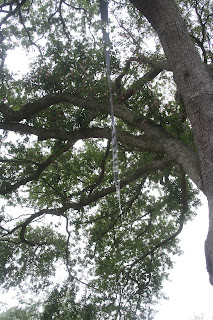I sprinted out my cube, into the parking lot, and partook in the 4SQRP club 4X4 Sprint.
:)
Here's what that means:
 | ||||
| 20m Vertical |
I get QRV^ on twenty because some time ago, I acquired an SW-20+ from AL7FS. He had an unbuilt kit, and was offering it at a fair price on QRP-L. I decided to buy it. I swapped the Killer Watt Radio* out for this, and have been using it for a while now. Turns out, I'd been a real QRP operator with that radio, because I thought I was putting out a buck and a quarter (1.25 watts) with it, but in reality, I was putting out 250 milliwatts! I had about 5 QSOs in the log with it before the 4x4 contest. After retweaking it to put out 1 watt with 8AA batteries for a power supply, I hit the field, hoping for a QSO. When I use the bench power supply, it's about 1.8 watts. The SW+ line is most efficient at 1.25, but can usually be tweaked out to about 2.2 watts without stability issues, if you heat sink the final transistor. I may decide at some point in time to put a diode in line with the bench PS, just for the drop in supply voltage, but not just yet. The Killer Watt Radio is in the wings though, it abides, waiting for the day I aquire Molex KK crimp terminals, but when they get here, and they are installed on the ends of my connectors... it will be awesome.
I needed an antenna that required minimal fuss to get put up. I tried the St Louis Vertical before, and while it's a great antenna for field ops, it requires some fussing with to get up up correctly. I've got some ideas for fixing it up right, but it's going to be a while before I get ready to work those issues out. When I get the Killer Watt Radio back in action, I'll go back to the SLV, until then, I use a 20m vertical. I choose to use the vertical design because they 'radiate equally poorly in all directions' or something like that :) I took a collapsible fishing pole I'd been using as a field antenna for 6m when I had an FT-817, and adapted it for 20 after building the radio months ago. I quickly discovered that I had been using poor math when planning the antenna. I knew I would be using just over 16.5 feet of speaker wire when setting the antenna up. I also knew that my fishing pole was 16 foot long, and that was close enough for me. Yippee, no worries! right? Wrong! When I initially created this antenna, I created it with with an elevated feedpoint. I did this on purpose. Why, I don't remember, but I know I had a reason! That shortened the usable amount of antenna length by about two and a half feet. I decided to ditch the top part of the antenna. It's Florida, and if I'm not at the beach, chances are, there's a tree near by, so I just stretch the radiator part up, and use the tree to keep it high. At home, I was able to get the SWR down to near perfect. In the field, I find that getting the radials deployed right is a little tougher, so I use an Emtech ZM-2 antenna tuner.
 | |
| Battle Station! |
20m is a Daytime band, it needs some sunshine to really be effective, and I got outside at 19:30 UTC, 3:30 pm local. Tuning around I could hear several stations calling CQ 4S, and threw my call out there to answer them. Three of them actually heard me well enough to call me back!
I worked KB4QQJ who was the loudest signal I heard, a genuine S-9 Plus, and there must have been a pipeline to his QTH in North Carolina because he gave me a 599 too. I tried really hard for about 15 minutes to work WA5BDU but just couldn't do it. He was loud, about 579, but there was QSB, and I think that's what got him down. I did work WA0ITP. WA0ITP was the weakest station I could copy. He was usually about 229, occasionally he was 559. I gave him a 229, and he gave me a 559. Unfortunately, that was it for my operating time, so QRT for me, and I clocked back in. I went back out after checking to make sure nothing had exploded, and managed to work KG3W who was 559 to me during my second 15 minute break. I tore the antenna down, and was content with my three QSOs. After the sprint, my membership in the 4SQRP club was approved, so next year I will be worth more points!
:)
When I got back inside, this dude was sitting by the badge access reader:
 | |
| You Can't See Me! |
73
^ I make extensive use of Q-codes. Q-codes are a kind of short hand when using Morse code. A list of common Q codes is here.
* The Killer Watt Radio is an SW+ on 40m, originally given to me as a gift for my birthday the year we moved to the current QTH. It may only radiate 1 watt of RF, but that 1 watt is 1 killer watt! Once again, this is humor. Laughter is appropriate.






























